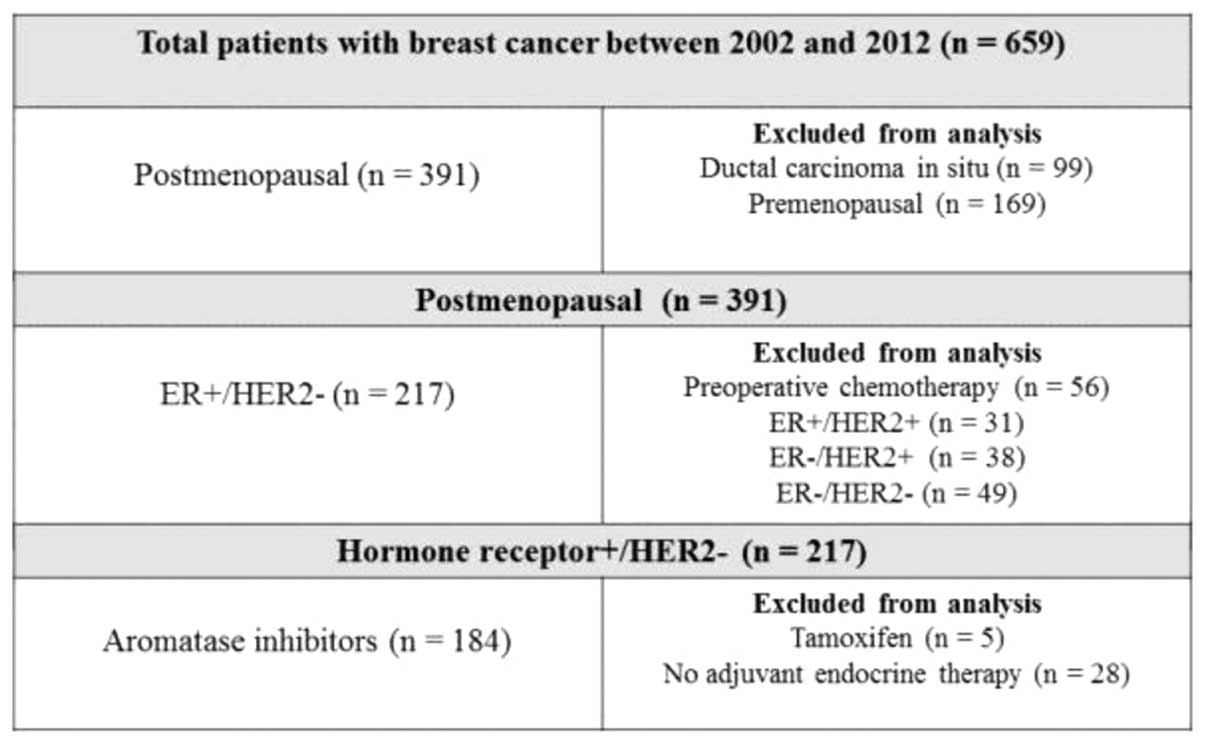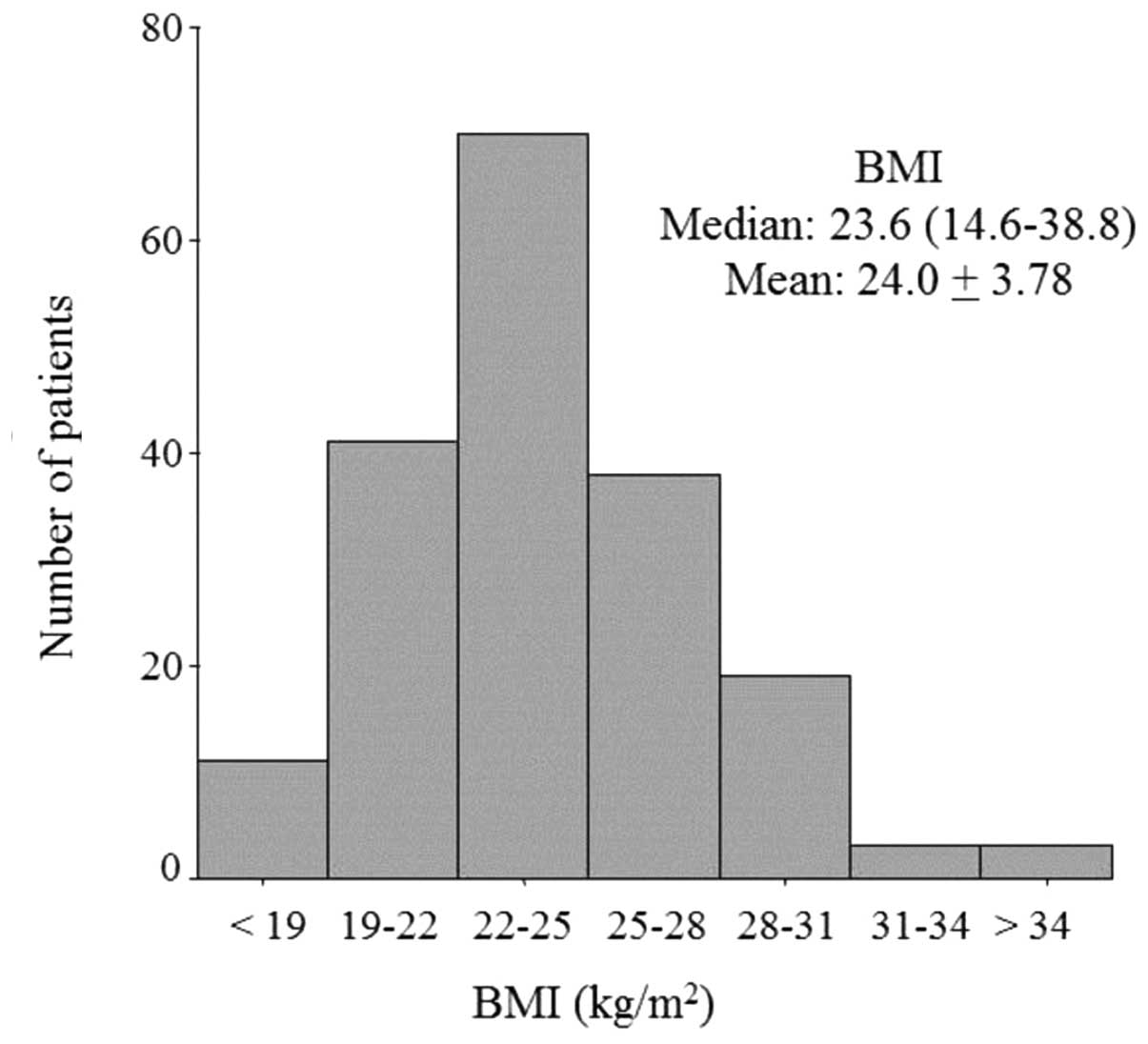|
1
|
Iwase H: Current topics and perspectives
on the use of aromatase inhibitors in the treatment of breast
cancer. Breast Cancer. 15:278–290. 2008. View Article : Google Scholar : PubMed/NCBI
|
|
2
|
Burstein HJ, Prestrud AA, Seidenfeld J,
Anderson H, Buchholz TA, Davidson NE, Gelmon KE, Giordano SH, Hudis
CA, Malin J, et al: American society of clinical oncology clinical
practice guideline: Update on adjuvant endocrine therapy for women
with hormone receptor-positive breast cancer. J Clin Oncol.
28:3784–3796. 2010. View Article : Google Scholar : PubMed/NCBI
|
|
3
|
Cardoso F, Harbeck N, Fallowfield L,
Kyriakides S and Senkus E: ESMO Guidelines Working Group: Locally
recurrent or metastatic breast cancer: ESMO Clinical Practice
Guidelines for diagnosis, treatment and follow-up. Ann Oncol.
21(Suppl 7): vii11–vii19. 2012.
|
|
4
|
Dowsett M, Allred C, Knox J, Quinn E,
Salter J, Wale C, Cuzick J, Houghton J, Williams N, Mallon E, et
al: Relationship between quantitative estrogen and progesterone
receptor expression and human epidermal growth factor receptor 2
(HER-2) status with recurrence in the arimidex, tamoxifen, alone or
in combination trial. J Clin Oncol. 26:1059–1065. 2008. View Article : Google Scholar : PubMed/NCBI
|
|
5
|
Viale G, Regan MM, Dell'Orto P,
Mastropasqua MG, Maiorano E, Rasmussen BB, MacGrogan G, Forbes JF,
Paridaens RJ, Colleoni M, et al: Which patients benefit most from
adjuvant aromatase inhibitors? Results using a composite measure of
prognostic risk in the BIG 1–98 randomized trial. Ann Oncol.
22:2201–2207. 2011. View Article : Google Scholar : PubMed/NCBI
|
|
6
|
Bartlett JM, Brookes CL, Robson T, van de
Velde CJ, Billingham LJ, Campbell FM, Grant M, Hasenburg A, Hille
ET, Kay C, et al: Estrogen receptor and progesterone receptor as
predictive biomarkers of response to endocrine therapy: A
prospectively powered pathology study in the tamoxifen and
exemestane adjuvant multinational trial. J Clin Oncol.
29:1531–1538. 2011. View Article : Google Scholar : PubMed/NCBI
|
|
7
|
Horwitz KB and McGuire WL: Oestrogen
control of progesterone receptor in human breast cancer:
correlation with nuclear processing of oestrogen receptor. J Biol
Chem. 253:2223–2228. 1978.PubMed/NCBI
|
|
8
|
Dowsett M, Houghton J, Iden C, Salter J,
Farndon J, A'Hern R, Sainsbury R and Baum M: Benefit from adjuvant
tamoxifen therapy in primary breast cancer patients according
oestrogen receptor, progesterone receptor, EGF receptor and HER2
status. Ann Oncol. 17:818–826. 2006. View Article : Google Scholar : PubMed/NCBI
|
|
9
|
Yamashita H, Iwase H, Toyama T, Takahashi
S, Sugiura H, Yoshimoto N, Endo Y, Fujii Y and Kobayashi S:
Estrogen receptor-positive breast cancer in Japanese women: Trends
in incidence, characteristics and prognosis. Ann Oncol.
22:1318–1325. 2011. View Article : Google Scholar : PubMed/NCBI
|
|
10
|
Berclaz G, Li S, Price KN, Coates AS,
Castiglione-Gertsch M, Rudenstam CM, Holmberg SB, Lindtner J, Erien
D, Collins J, et al: Body mass index as a prognostic feature in
operable breast cancer: The international breast cancer study group
experience. Ann Oncol. 15:875–884. 2004. View Article : Google Scholar : PubMed/NCBI
|
|
11
|
Elliot KM, Dent J, Stanczyk FZ, Woodley L,
Coombes RC, Purohit A and Palmieri C: Effects of aromatase
inhibitors and body mass index on steroid hormone levels in women
with early and advanced breast cancer. Br J Surg. 101:939–948.
2014. View
Article : Google Scholar : PubMed/NCBI
|
|
12
|
Slamon DJ, Leyland-Jones B, Shak S, Fuchs
H, Paton V, Bajamonde A, Fleming T, Eiermann W, Wolter J, Pegram M,
et al: Use of chemotherapy plus a monoclonal antibody against HER2
for metastatic breast cancer that overexpresses HER2. N Engl J Med.
344:783–792. 2001. View Article : Google Scholar : PubMed/NCBI
|
|
13
|
Goldhirsch A, Glick JH, Gelber RD, Coates
AS, Thürlimann B and Senn HJ: Panel members: Meeting highlights:
International expert consensus on the primary therapy of early
breast cancer 2005. Ann Oncol. 16:1569–1583. 2005. View Article : Google Scholar : PubMed/NCBI
|
|
14
|
Goldhirsch A, Wood WC, Gelber RD, Coates
AS, Thürlimann B and Senn HJ: 10th St. Gallen conference: Progress
and promise: Highlights of the international expert consensus on
the primary therapy of early breast cancer 2007. Ann Oncol.
18:1133–1144. 2007. View Article : Google Scholar : PubMed/NCBI
|
|
15
|
Goldhirsch A, Ingle JN, Gelber RD, Coates
AS, Thürlimann B and Senn HJ: Panel members: Thresholds for
therapies: Highlights of the St Gallen international expert
consensus on the primary therapy of early breast cancer 2009. Ann
Oncol. 20:1319–1329. 2009. View Article : Google Scholar : PubMed/NCBI
|
|
16
|
Goldhirsch A, Wood WC, Coates AS, Gelber
RD, Thürlimann B and Senn HJ: Panel members: Strategies for
subtypes-dealing with the diversity of breast cancer: Highlights of
the St. Gallen International expert consensus on the primary
therapy of early breast cancer 2011. Ann Oncol. 22:1736–1747. 2011.
View Article : Google Scholar : PubMed/NCBI
|
|
17
|
Goldhirsch A, Winer EP, Coates AS, Gelber
RD, Piccart-Gebhart M, Thürlimann B and Senn HJ: Panel members:
Personalizing the treatment of women with early breast cancer:
Highlights of the St Gallen international expert consensus on the
primary therapy of early breast cancer 2013. Ann Oncol.
24:2206–2223. 2013. View Article : Google Scholar : PubMed/NCBI
|
|
18
|
National Comprehensive Cancer Network:
NCCN Guidelines - Breast Cancer. http://www.nccn.org/professionals/physician_gls/f_guidelines.aspAccessed.
April 1st–2012
|
|
19
|
WHO Expert Consultation: Appropriate
body-mass index for Asian populations and its implications for
policy and intervention strategies. Lancet. 363:157–163. 2004.
View Article : Google Scholar : PubMed/NCBI
|
|
20
|
The Japanese Breast Cancer Society:
General rules for clinical and pathological recording of breast
cancer (16th). Kanehara, Tokyo: 2008.
|
|
21
|
Allred DC, Harvey JM, Berardo M and Clark
GM: Prognostic and predictive factors in breast cancer by
immunohistochemical analysis. Mod Pathol. 11:155–168.
1998.PubMed/NCBI
|
|
22
|
Kai K, Nishimura R, Arima N, Miyayama H
and Iwase H: p53 expression status is a significant molecular
marker in predicting the time to endocrine therapy failure in
recurrent breast cancer: A cohort study. Int J Clin Oncol.
11:426–433. 2006. View Article : Google Scholar : PubMed/NCBI
|
|
23
|
Ohara M, Shigematsu H, Tsutani Y, Emi A,
Masumoto N, Ozaki S, Kadoya T and Okada M: Role of FDG-PET/CT in
evaluating surgical outcomes of operable breast cancer-usefulness
for malignant grade of triple-negative breast cancer. Breast.
22:958–963. 2013. View Article : Google Scholar : PubMed/NCBI
|
|
24
|
Sestak I, Distler W, Forbes JF, Dowsett M,
Howell A and Cuzick J: Effect of body mass index on recurrences in
tamoxifen and anastrozole treated women: An exploratory analysis
from the ATAC trial. J Clin Oncol. 28:3411–3415. 2010. View Article : Google Scholar : PubMed/NCBI
|
|
25
|
Ewertz M, Gray KP, Regan MM, Ejlertsen B,
Price KN, Thürlimann B, Bonnefoi H, Forbes JF, Paridaens RJ,
Rabaglio M, et al: Obesity and risk of recurrence or death after
adjuvant endocrine therapy with letrozole or tamoxifen in the
breast international group 1–98 trial. J Clin Oncol. 30:3967–3975.
2012. View Article : Google Scholar : PubMed/NCBI
|
|
26
|
Seynaeve C, Hille E, Hasenburg A, Rea D,
Markopoulos C, Hozumi Y, Putter H, Nortier H, van Nes J, Dirix L
and van de Velde C: Impact of body mass index (BMI) on the efficacy
of adjuvant endocrine therapy in postmenopausal hormone sensitive
breast cancer (BC) patients; Exploratory analysis from the TEAM
study. Cancer Res. 70:Abstract S2–S3. 2010. View Article : Google Scholar
|
|
27
|
Goodwin PJ: Obesity and endocrine therapy:
Host factors and breast cancer outcome. Breast. 22(Suppl 2):
S44–S47. 2013. View Article : Google Scholar : PubMed/NCBI
|
|
28
|
Sendur MA, Aksoy S, Zengin N and Altundag
K: Efficacy of adjuvant aromatase inhibitor in hormone
receptor-positive postmenopausal breast cancer patients according
to the body mass index. Br J Cancer. 107:1815–1819. 2012.
View Article : Google Scholar : PubMed/NCBI
|
|
29
|
Hankinson SE, Willett WC, Manson JE,
Hunter DJ, Colditz GA, Stampfer MJ, Longcope C and Speizer FE:
Alcohol, height and adiposity in relation to estrogen and prolactin
levels in postmenopausal women. J Natl Cancer Inst. 87:1297–1302.
1995. View Article : Google Scholar : PubMed/NCBI
|
|
30
|
Mahabir S, Baer DJ, Johnson LL, Hartman
TJ, Dorgan JF, Campbell WS, Clevidence BA and Taylor PR: Usefulness
of body mass index as a sufficient adiposity measurement for sex
hormone concentration associations in postmenopausal women. Cancer
Epidemiol Biomarkers Prev. 15:2502–2507. 2006. View Article : Google Scholar : PubMed/NCBI
|
|
31
|
McTiernan A, Rajan KB, Tworoger SS, Irwin
M, Bernstein L, Baumgartner R, Gilliland F, Stanczyk FZ, Yasui Y
and Ballard-Barbash R: Adiposity and sex hormones in postmenopausal
breast cancer survivors. J Clin Oncol. 21:1961–1966. 2003.
View Article : Google Scholar : PubMed/NCBI
|
|
32
|
Folkerd EJ, Dixon JM, Renshaw L, A'Hern RP
and Dowsett M: Suppression of plasma estrogen levels by letrozole
and anastrozole is related to body mass index in patients with
breast cancer. J Clin Oncol. 30:2977–2980. 2012. View Article : Google Scholar : PubMed/NCBI
|
|
33
|
Pfeiler G, Königsberg R, Hadji P, Fitzal
F, Maroske M, Dressel-Ban G, Zellinger J, Exner R, Seifert M,
Singer C, et al: Impact of body mass index on estradiol depletion
by aromatase inhibitors in postmenopausal women with early breast
cancer. Br J Cancer. 109:1522–1527. 2013. View Article : Google Scholar : PubMed/NCBI
|
|
34
|
Sini V, Lunardi G, Cirillo M, Turazza M,
Bighin C, Giraudi S, Levaggi A, Piccioli P, Bisagni G, Gnoni R, et
al: Body mass index and circulating oestrone sulphate in women
treated with adjuvant letrozole. Br J Cancer. 110:1133–1138. 2014.
View Article : Google Scholar : PubMed/NCBI
|
|
35
|
Lønning PE, Haynes BP and Dowsett M:
Relationship of body mass index with aromatisation and plasma and
tissue oestrogen levels in postmenopausal breast cancer patients
treated with aromatase inhibitors. Eur J Cancer. 50:1055–1064.
2014. View Article : Google Scholar : PubMed/NCBI
|
|
36
|
Folkerd EJ, Dixon JM, Renshaw L, A'Hern RP
and Dowsett M: Suppression of plasma estrogen levels by letrozole
and anastrozole is related to body mass index in patients with
breast cancer. J Clin Oncol. 30:2977–2988. 2012. View Article : Google Scholar : PubMed/NCBI
|
|
37
|
Arafah BM, Finegan HM, Roe J, Manni A and
Pearson OH: Hormone dependency in N-nitrosomethylurea-induced rat
mammary tumors. Endocrinology. 111:584–588. 1982. View Article : Google Scholar : PubMed/NCBI
|
|
38
|
Brisken C: Progesterone signalling in
breast cancer: A neglected hormone coming into the limelight. Nat
Rev Cancer. 13:385–396. 2013. View
Article : Google Scholar : PubMed/NCBI
|













